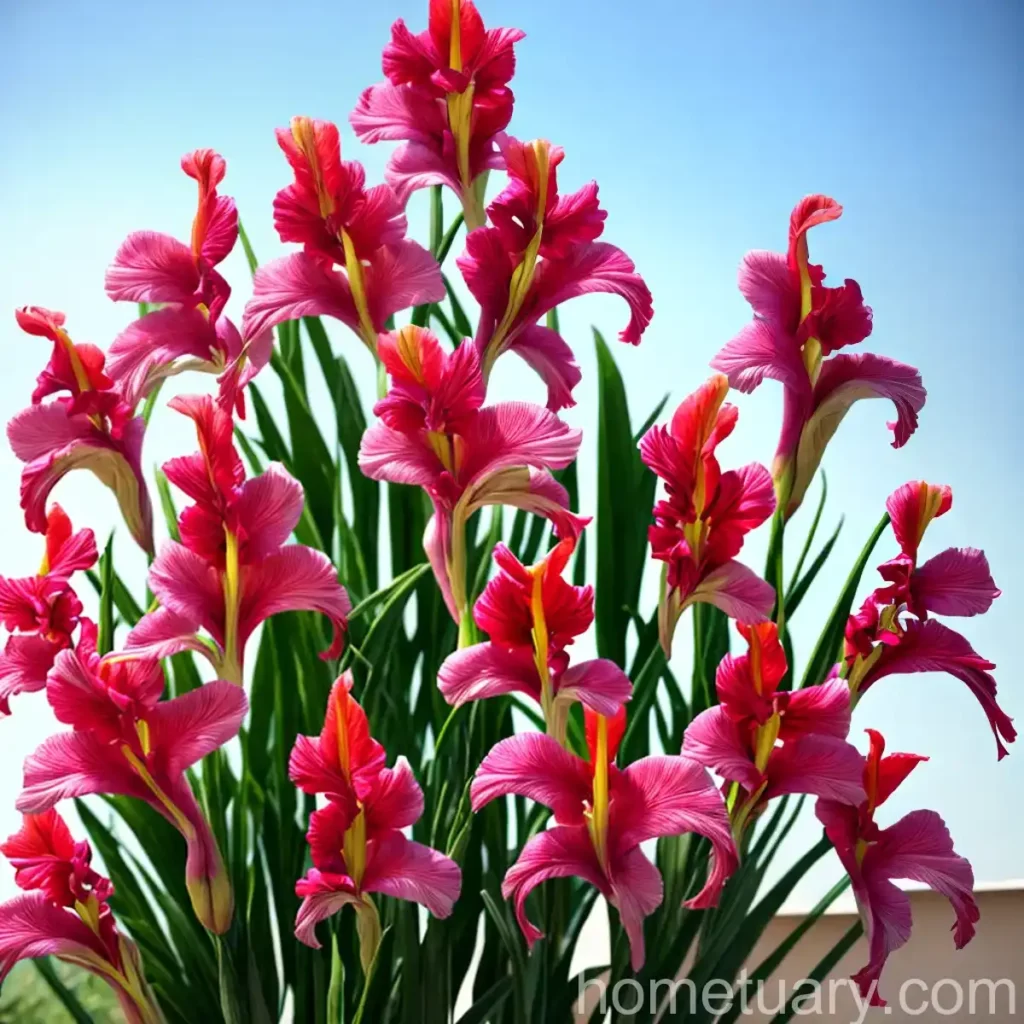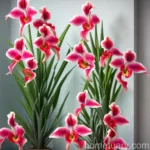The Glorious Gladiolus (Gladiolus (hardy mix))
Unveiling the Beauty and Nurturing the Growth
In the world of flora, few plants can match the elegance and grandeur of the gladiolus. Whether in gardens, bouquets, or floral arrangements, gladiolus’s vibrant colors and towering spikes never fail to captivate onlookers. This article delves into the enchanting world of gladiolus (Gladiolus (hardy mix)), exploring its culture, uses, care, and propagation while also providing insights into common diseases and pests. Join me as we uncover the secrets to nurturing these majestic blooms and discover the many facets of the gladiolus plant.
What is Gladiolus (Gladiolus (hardy mix))?
Before we delve into the intricate details of this captivating plant, let’s take a moment to understand the basics. Gladiolus (Gladiolus (hardy mix)) is a member of the Iridaceae family, commonly referred to as the iris family. This stunning plant is renowned for its striking, sword-shaped leaves and its impressive, showy flower spikes. The gladiolus is a cormous plant, meaning it grows from a corm, a bulb-like structure that stores nutrients for the plant’s growth and development.
Gladiolus (Gladiolus (hardy mix)) is valued for its versatility, as it can be cultivated both in the garden and in containers, making it a favorite among gardening enthusiasts and florists alike. The hardy mix variety encompasses a range of gladiolus cultivars, offering a diverse palette of colors and forms, adding an extra dimension of beauty to any space where they are grown or displayed.
Key Takeaways – Gladiolus (Gladiolus (hardy mix))
Here are a few key takeaways about gladiolus (Gladiolus (hardy mix)):
– Valued for its vibrant and showy flower spikes
– A cormous plant that stores nutrients in bulb-like structures
– Versatile in its uses, suitable for garden cultivation and container gardening
– Available in a wide range of colors and forms, thanks to the hardy mix variety
Culture
Understanding the culture of gladiolus (Gladiolus (hardy mix)) is pivotal to ensuring its optimal growth and development. From planting to maintenance, adhering to the appropriate cultural practices is crucial for nurturing healthy and vibrant gladiolus blooms.
Uses
The uses of gladiolus (Gladiolus (hardy mix)) are multifaceted, offering both ornamental and utilitarian value. Some common uses include:
– Garden Ornament: Gladiolus adds vertical interest to gardens, thanks to its tall flower spikes and vivid colors.
– Cut Flowers: Often used in floral arrangements and bouquets, gladiolus blooms are prized for their striking appearance and longevity.
– Decorative Containers: With suitable care, gladiolus can be grown successfully in containers, enhancing balconies and patios with their colorful display.
Water
Proper watering is essential for the health and vitality of gladiolus plants. These are a few crucial water-related considerations:
– Regular Watering: During the growing season, maintain consistent soil moisture by watering the plants regularly, especially during dry spells.
– Avoid Overwatering: While gladiolus requires ample moisture, overwatering can lead to waterlogged soil, potentially causing corms to rot.
Sunlight
Vibrant blooms and sturdy growth in gladiolus plants are heavily dependent on adequate sunlight. Key points to note include:
– Full Sun: Gladiolus thrives in full sunlight, requiring at least 6-8 hours of direct sunlight daily.
– Shelter from Strong Winds: Position plants in locations protected from strong winds, as the tall flower spikes can be vulnerable to damage in exposed settings.
Fertilizer
Proper fertilization plays a pivotal role in supporting the growth and blooming of gladiolus plants. Here are some essential fertilizer guidelines:
– Balanced Fertilizer: Use a balanced fertilizer with equal parts of nitrogen, phosphorus, and potassium to promote healthy foliage and robust blooms.
– Application Timing: Begin fertilizing when new growth emerges, continuing every 2-3 weeks until the flowering period ends.
Soil
The choice of soil greatly influences the growth and development of gladiolus plants. Consider the following soil-related aspects:
– Well-Draining Soil: Gladiolus thrives in well-draining soil, as waterlogged conditions can lead to corm rot.
– Soil pH: Aim for a slightly acidic to neutral pH range (6.0-7.0) for optimal nutrient uptake.
Pruning
Pruning practices are essential for maintaining the health and vigor of gladiolus plants. Here are some key aspects of pruning:
– Deadheading: Remove spent blooms to encourage continuous flowering and prevent seed formation, which can divert the plant’s energy.
– Limb Trimming: Trim off any damaged or diseased foliage to promote air circulation and prevent the spread of diseases.
Propagation
Propagating gladiolus (Gladiolus (hardy mix)) allows enthusiasts to expand their collection and share the beauty of these blooms with others. Here’s a look at the propagation methods for gladiolus plants:
– Corm Division: Divide mature corms into smaller sections, ensuring each division has viable buds for new growth.
– Offsets: Separate and replant the offsets, which are the small cormels that develop around the base of the parent corm.
Container Popularity
The versatility of gladiolus makes it a popular choice for container gardening. Here are some reasons why it is favored for container cultivation:
– Space Efficiency: Ideal for those with limited garden space, as the tall flower spikes provide vertical interest without occupying a large ground area.
– Decoration: Adds a vibrant and eye-catching element to balconies, patios, and terrace gardens, enhancing the visual appeal of these spaces.
Common Diseases
While gladiolus (Gladiolus (hardy mix)) is a resilient plant, it is susceptible to certain diseases that can impact its growth and vitality. Here are some common diseases to watch out for:
| Disease | Symptoms | Management |
|---|---|---|
| Botrytis Blight | Brown lesions on foliage and flowers | Remove infected plant parts and improve air circulation |
| Fusarium Rot | Rotting corms and stunted growth | Practice crop rotation and avoid waterlogged soil |
| Rust | Orange powdery spots on leaves | Remove affected foliage and consider fungicidal treatments |
| Leaf Blight | Brown spots and leaf yellowing | Proper sanitation and removal of infected plant debris |
Disease Diagnosis
Prompt diagnosis and intervention are crucial for managing diseases in gladiolus plants. The following symptoms can indicate potential diseases:
- Wilting or Yellowing Leaves: May signify root or corm rot.
- Spots or Lesions on Foliage: Could be indicative of fungal diseases such as botrytis blight or rust.
- Stunted Growth: Often a sign of underlying issues such as fusarium rot.
Common Pests
A few common pests pose a threat to the health and vigor of gladiolus plants. Vigilance and proactive pest management are essential to protect the plants from infestations. Here are some typical pests to be mindful of:
| Pest | Symptoms | Management |
|---|---|---|
| Thrips | Scarring and distortion of flower buds and petals | Use insecticidal soap and maintain a clean garden environment |
| Aphids | Clusters of insects on new growth | Introduce beneficial insects or use neem oil for control |
| Spider Mites | Fine webbing and stippled foliage | Increase humidity and consider predatory mites for control |
| Snails and Slugs | Irregular holes in leaves and flowers | Employ physical barriers and organic baits for management |
Botanist’s Tips
As a plant scientist, I have gathered insightful tips for cultivating and caring for gladiolus plants. These tips can help enthusiasts achieve thriving and beautifully blooming gladiolus displays:
- Adequate Spacing: When planting gladiolus corms, provide adequate spacing to allow for optimal growth and air circulation.
- Mulching: Apply a layer of mulch around gladiolus plants to regulate soil moisture and inhibit weed growth.
- Support for Tall Varieties: Stake tall gladiolus cultivars to prevent flopping and damage to the flower spikes.
Fun Facts
Let’s conclude our deep dive into the world of gladiolus (Gladiolus (hardy mix)) with some captivating and little-known facts about these enchanting blooms:
1. Gladiolus flowers are often used to symbolize strength, integrity, and infatuation, making them a popular choice for gift bouquets and arrangements.
2. The name “gladiolus” is derived from the Latin word for “little sword,” a reference to the plant’s sword-shaped leaves.
3. Gladiolus plants can produce a succession of blooms, with each flower spike bearing numerous blossoms, providing an extended flowering period.
Links to External Resources
For further exploration of gladiolus cultivation, care, and maintenance, I recommend these external resources:
– The American Gladiolus Society
– University of Minnesota Extension – Growing Gladiolus
– Royal Horticultural Society – Gladiolus and Acidanthera
By embracing the insights and guidelines shared in this article, you can embark on a rewarding journey of nurturing and celebrating the beauty of gladiolus (Gladiolus (hardy mix)) in your own garden or living space. Here’s to a flourishing display of these majestic blooms gracing your surroundings with their vibrant hues and elegant form. Happy gardening and may your gladiolus garden be a source of joy and admiration for all who behold it!















